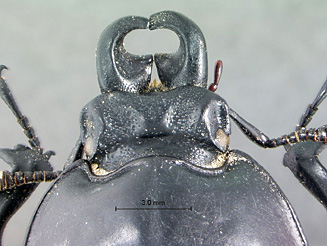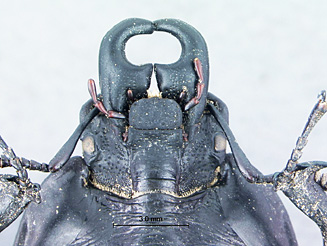|
Colophon montisatris
Endrödy-Younga,
1988
Life > Eukaryotes > Opisthokonta > Metazoa (animals) > Bilateria > Ecdysozoa > Panarthropoda > Tritocerebra > Arthopoda > Mandibulata > Atelocerata > Panhexapoda > Hexapoda > Insecta (insects) > Dicondyla > Pterygota > Metapterygota > Neoptera > Eumetabola > Holometabola > Coleoptera (beetles) > Polyphaga > Superfamily: Scarabaeoidea > Family: Lucanidae > Subfamily: Lucaninae > Genus: Colophon
Found in
the Blesberg, Swartberg Range. Little is known about its biology but larvae
probably feed on plant roots such as Restioniaceae. Male 23-28mm, female 23mm.
|
 |
 |
|
Colophon montisatris, male.
Dorsal view of head and thorax.
I[image
M. Cochrane, Iziko
© ] |
Colophon montisatris, male.
Ventral view of head and thorax.
[image
M. Cochrane, Iziko
© ] |
Apomorphic species.
Aedeagus
(penis and parameres) are
distinctly asymmetrical, the right paramere is strongly dilated forming a
hook on the inner margin with the anal sternite correspondingly asymmetrical on
the posterior margin; penis well sclerotised (cuticle hardened); anterior
(front) margin of the clypeus raised above the level of the labrum at the suture
(join). Compare genitalia of species groups.
This
group includes Colophon
barnardi, Colophon berrisfordi,
Colophon
cassoni, Colophon endroedyi, Colophon izardi,
Colophon montisatris,
Colophon
neli, Colophon oweni,
Colophon
primosi, Colophon
thunbergi, Colophon
westwoodi and Colophon
whitei.
Publications
-
ENDRÖDY-YOUNGA,
S. 1988. Evidence for the low-altitude origin of the Cape Mountain Biome derived
from the systematic revision of the genus Colophon
Gray (Coleoptera, Lucanidae). Annals of the South African Museum 96(9) 359 –
424.
Colophon
home
Images and text by Margie Cochrane |
